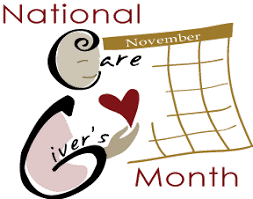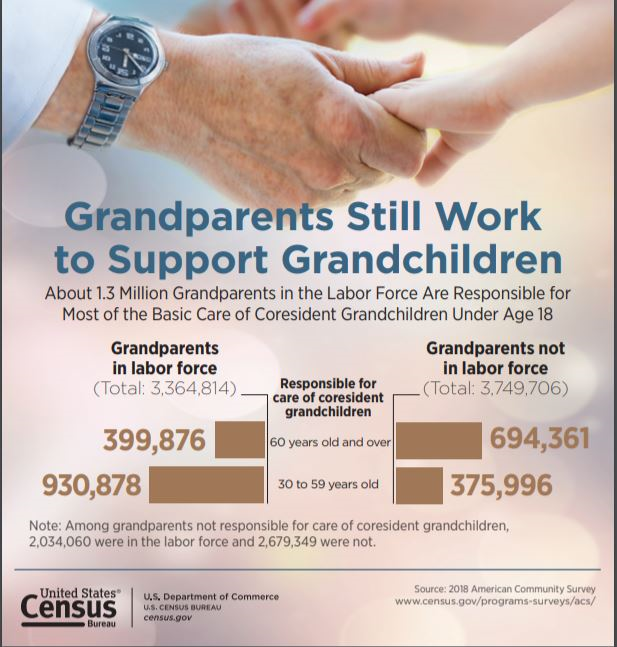November is a month to celebrate the over 40 million care givers across the country.
View as PDF
View this email on our site
Subscribe to this newsletter

School & Home Integrated Pest Management (IPM)
Newsletter – November 2019
Please consider distributing this newsletter within the state of Arizona. If you work in education please let us know if you send this on to anyone in the following groups: school staff, faculty, students, and/or parents and guardians.
November Is National Family Caregiver’s Month
Since at least 2000, presidents have designated November as National Family Caregivers Month to honor the more than 40 million caregivers across the country who support dependent parents, spouses, children, or other loved ones. In addition to paid caregivers, there are an estimated 16.8 million unpaid caregivers who provide care to a child with special needs under the age of 18 in the U.S.
The 2018 American Community Survey conducted by the United States Census Bureau, reveals that grandparents work significantly to support grandchildren. However, in well over a million American families, this pattern is reversed with children as young as 8, 9 or 10 partly or fully responsible for the welfare of adults or siblings they live with.
Children, the elderly, and those in poor health are the most vulnerable to adverse effects of pest exposure
and poor pest management practices.
This month is dedicated to the in-home and professional caregivers of Arizona.
Bed bugs: Information for Home Care Providers and Welfare Workers
This information is also available as a printable trifold:
Shaku Nair, Associate in Extension – AZ School IPM Coordinator
Dawn H. Gouge, Professor, Public Health Entomology
Shujuan (Lucy) Li, Assistant in Extension – Public Health IPM
University of Arizona
About Bed Bugs
Bed bugs are small, flat, reddish-brown insects, that feed on the blood of humans. Bed bugs do not transmit disease-causing pathogens. Adult bed bugs are about ¼ inch in length with a flat oval shape and are about the size of an apple seed. They do not jump or fly, but can crawl quickly. Bed bugs generally feed at night and during the day hide in cracks and crevices close to resting areas.
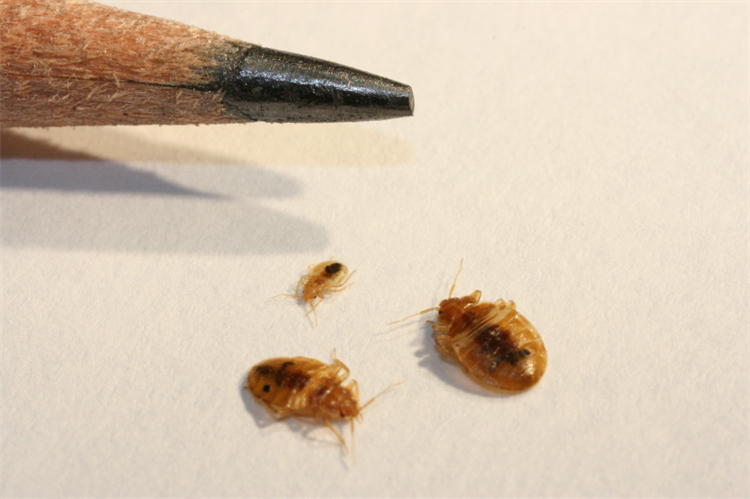
Bed bugs next to a pencil point for scale
Anyone can acquire bed bugs
Bed bugs are often found everywhere people go. They hitchhike on clothing and personal items, and sometimes drop off, as people with bed bug infestations at home go about their daily life. Bed bugs introduced into new places in this way rarely survive, but are sometimes found roving around an area looking for a protective crack or crevice. Person-to-person transfer of bed bugs is unlikely in most instances. However, if your job involves visiting homes, or interacting physically with lots of people, extra precautions should be taken to minimize the risk of accidently picking up an unwanted hitchhiker.
Where bed bugs are found
Bed bugs are most likely to be found in and near beds, couches, or chairs in which people rest for multiple hours at a time. Clusters of dark spots on mattresses and bedding, and bites on the skin may indicate the presence of bed bugs (Fig. 2).
Preparing to visit a home
- Have a spare set of clothes and shoes at the office or in your car. Large plastic bags to cover car seats after a visit are also helpful.
- Wear simple, light-colored clothing and shoes, without lots of pockets, cuffs, seams or folds. Choose materials that can be washed and dried in a clothes dryer.
- Avoid carrying lots of accessories such as scarves, hats and handbags. Carry minimal items into the residence. If you need to carry paperwork, and equipment use zipper style bags that can be discarded or carrier bags that can be laundered and dried in a clothes dryer.
- Carry a flashlight to use when making observations about living conditions.
- Use white bed sheets or foldout play mats to kneel on if your job entails interacting with children at floor level. Avoid reusing these items in multiple homes without laundering them between visits.
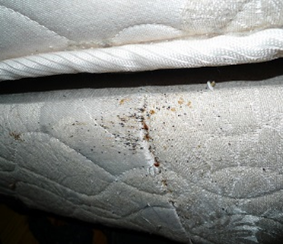
Dark spots on your bed
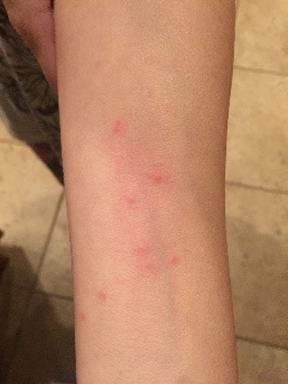
Bites can occur singly, in clusters, or in lines. Reactions to bites are highly variable and may show up within hours, weeks, or not at all.
When you arrive at a location
-
If an infestation has been confirmed or is anticipated, consider wearing disposable shoe covers to avoid collecting bed bugs on the undersides of shoes and relocating them to other homes. If you do not have these available simply check the undersides of your shoes when you leave.
-
If possible, avoid sitting on upholstered furniture or beds. Try to sit on a hard surface chair, or carry your own foldable chair.
-
If you observe bed bugs during your visit, do not panic. Make a note, so you can be prepared next time. Encourage residents to talk openly about pest infestations, bites, and pesticide use.
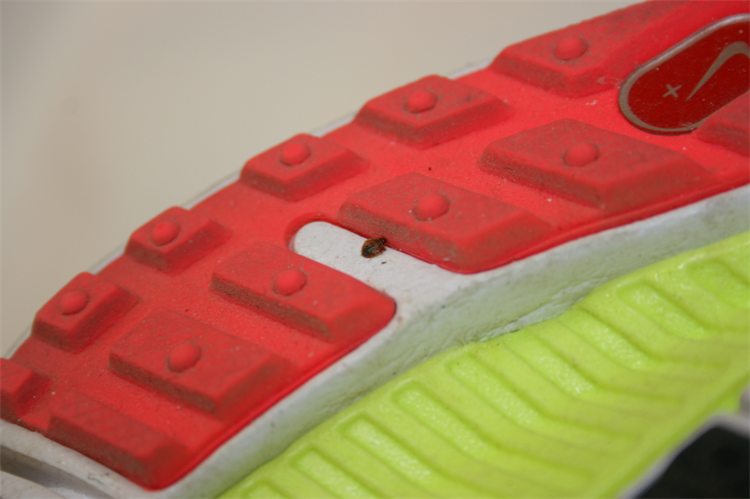
A bed bug hitching a ride on the sole of a shoe
After leaving
- Remove disposable shoe covers and place them in a sealable plastic bag for later disposal in an external garbage receptacle.
- Inspect yourself thoroughly, looking for any bed bugs or other pests on yourself. Carefully check your clothes, under your shoes, and items taken inside. Use a hand mirror to inspect the back of your pants or under your shoes if shoe covers were not worn.
- If you find an insect on yourself, use a tissue or lint roller to pick it up, and place it in a sealable plastic bag. Discard or save it for identification confirmation if you are uncertain what the insect is.
- If you have observed bed bugs in a resident’s home that staff routinely visit, notify your supervisor so others can be prepared.
- If you suspect you may have bed bugs on yourself after an in-home visit, avoid subsequent home visits before changing clothes and shoes. Return home, or to your office if it is equipped with a shower, washer and dryer.
The provision of laundry facilities, showering and changing rooms in offices where employees regularly visit bed bug infested environments enables employees to launder work clothes at the office and return to their duties with minimal interruption.
Upon returning home (if you do not have laundering and changing facilities at work):
- Remove your footwear, bags, and leave them outside the home, or in the garage.
- Undress directly into a clothes washer if possible, or into plastic bags in a bathroom area that is not a part of your bed room. Double bag clothing until you can launder and dry the items as soon as possible. Avoid bringing worn items into bedrooms or placing items on furniture.
- Showering using soap and water is sufficient to remove bed bugs from your person.
- Wash your work clothes and dry them completely in a clothes dryer. Once dry, run the clothes on high heat for an additional 30 minutes to make certain that any bed bugs transferred from the washing machine are dead. Heat kills all life stages of bed bugs. Washing alone will not kill them. Dry-cleaning also effectively kills bed bugs.
-
Inspect shoes, bags, and other items carefully before unpacking items in your home. Some shoes can be heated in a clothes dryer by hanging laces over the dryer door and leaving the shoes hung inside.
- Delicate items can be bagged and placed in a freezer for 4 days to kill bed bugs.
- Vacuuming personal and work vehicles regularly is advisable, especially if you transport persons or items from infested homes.
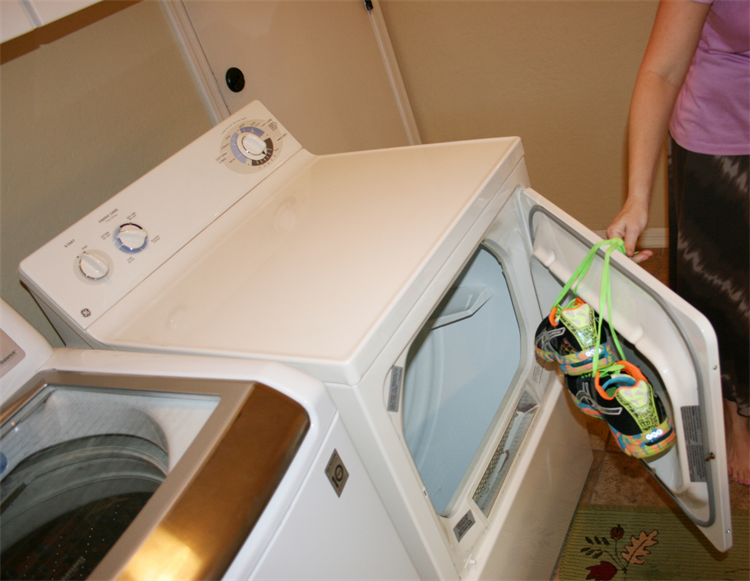
Heat treating shoes in a home dryer.
If you find bed bugs at home
Try not to panic; bed bugs do not transmit disease-causing pathogens. The sooner you seek pest control assistance, the easier, faster, and cheaper it will be to eradicate them from your home. Find out your employer’s policy regarding helping employees with bed bugs, some may provide financial help. Find out what your lease agreement is if you are a renter, you may or may not be responsible for the costs. Find an experienced pest management company to exterminate the pest. Bed bugs are challenging insects to control, and require specialized products, equipment, and knowledge to eradicate.
Further Information
Webinars and Events
Please join in for the
2019 All Bugs Good and Bad Webinar Series. This webinar series provides information about good and bad insects. Webinars are free and open to everyone. Webinars will be on the
first Friday of each month at 2p.m. Eastern time.

Acknowledgements
This material is in part funded by the Extension Strategic Investment Fund 2018, and in part by the National Institute of Food and Agriculture, U.S. Department of Agriculture, under award number 2017-70006-27145 that provides Extension IPM funding to the University of Arizona. Additional support is provided by the University of Arizona – Arizona Pest Management Center.


